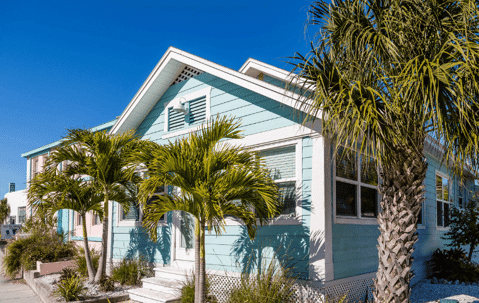What Palm Trees Can I Grow In West Palm Beach?
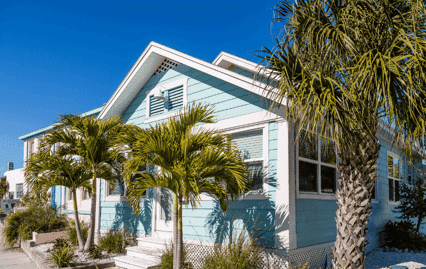
What Palm Trees Can I Grow In West Palm Beach?
Palm trees in West Palm Beach are a signature touch. Luckily, South Florida’s sunny days, humid nights, and ocean views are the perfect climate for all kinds of tropical trees.
If you’re looking to turn your home into the tropical getaway of your dreams, adding a palm tree is a great step to take. Whether you’re looking for a show-stopping tree for your backyard or a tropical plant that will add color to your living room, the perfect palm is out there for you.
These are some of the most popular palm trees in West Palm Beach, FL and the best part is they all have their own unique features - keep reading to learn about them!
Coconut Palm - Coco Nucifera
The coconut palm is the ultimate tropical palm - think about it, how many times have you daydreamed of sitting under a coconut tree?
The coconut palm originates from the Austronesians in the Neolithic era, 12,000 years ago. The Austronesians include people from Taiwan, Maritime Southeast Asia, Micronesia, coastal New Guinea, Island Melanesia, Polynesia, and Madagascar.
They used coconut meat, coconut milk, and coconut oil as their main food source, so coconuts were pretty much a way of life.
The coconut palm is anything but underwhelming. These trees can be up to 100 feet tall, and in the most optimal conditions, can grow anywhere from 12-36 inches per year.
These palms are extremely sensitive to the cold, so if you live in West Palm Beach, lucky you! Rarely dipping below 60 degrees, the weather is perfect for growing coconut palms outside.
The coconut palm can thrive in temperatures down to 40 degrees Fahrenheit. After that, the tree starts to get damaged. At continuous exposure to 30 degree temperatures, the coconut palm will die.
Not every area in Florida can grow a coconut palm, so living in sunny West Palm Beach can be the perfect opportunity.
And yes, they grow coconuts even in West Palm Beach! But keep in mind, it takes a little bit of time for them to show up so patience is key.
The coconut palm starts producing coconuts after living for 6-10 years. At 15-20 years, they can produce up to 50 coconuts every year.
That’s definitely something worth waiting for!
If you plan on planting a coconut palm in your yard, make sure you use sandy soil or loamy ground (sand, silt, and clay soil) and that it gets one inch of water per week.
Did you know there are dwarf versions of the coconut palm?
So if you’re wary of a palm towering 100 feet over you (even though it takes years to reach that point), consider a dwarf coconut palm variety.
The Malayan dwarf reaches about 16 to 30 feet tall and is slower growing.
Telling your neighbors you grow coconuts in your yard is definitely something to brag about, so the coconut palm would definitely be a great option.
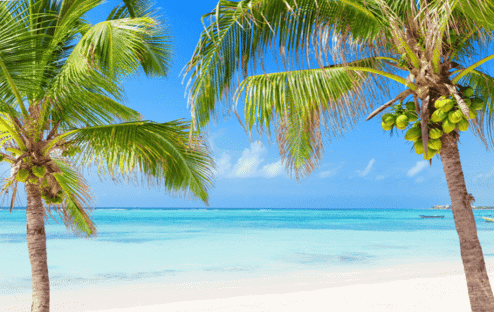
Chinese Fan Palm - Livistona chinensis
The Chinese fan palm, nicknamed the fountain palm, is native to China and Japan.
These slow-growing palms reach about 30 ft tall and live for around 40 years under proper conditions.
These take a twist on the tropical vibe and have an elegant flair at maturity. Although they can survive up to temperatures of 15-20 degrees, they need 6 to 8 hours of sunlight daily to thrive. That’s a lot of sun!
If the Chinese fan is intriguing but you still want to explore more options, consider checking these out.
Chinese fan palm variations:
- The European fan, which is the only palm native to Europe
- The California fan which is popular out West, but still can flourish in West Palm Beach
- The real fan palm, also known as the Makalani palm, which comes from south-central Africa
The Chinese fan might be for you if you want something tropical but with a little *spice*.
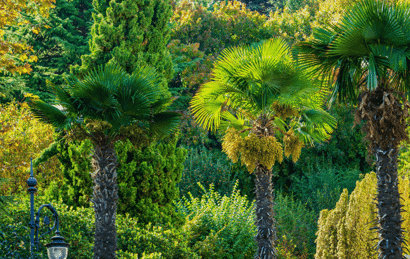
Pygmy Date Palm - Phoenix roebelenii
The pygmy (pig · mee) date palm comes from Southeast Asia where it grows along river banks - so, you could imagine it has standards when it comes to water and soil.
You’ll want to water your pygmy date palm tree regularly, but don’t go crazy - too much can lead to root rot.
And make sure you plant it in well-draining soil, preferably on the sandy side.
How do you know your soil is well-draining? I gotchu!
First, you want to dig a hole around one foot deep and 8 to 12 inches wide, then fill it with water. Wait 12 hours to refill it and track how long it takes to drain.
If the soil is well-draining, the water will be gone in 2 to 3 hours.
Test your soil drainage before you plant your pygmy date palm so you can ensure they have the best nutrients to grow and thrive.
Anyone with a pygmy date palm will be excited to tell you it grows *edible* fruit and fragrant yellow flowers, so it has all kinds of great things going on.
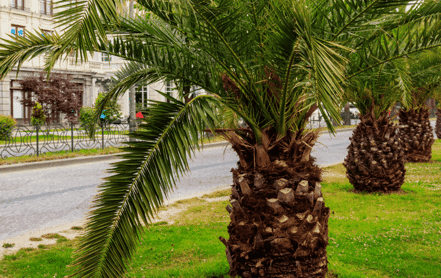
Royal Palm - Roystonea elata
The royal palm does in fact live up to its name. With the potential to reach 125 feet tall, this true palm is quick to impress.
And there are actually two kinds of royal palms - the Florida royal palm and the Cuban royal palm. If you’re reading this, you likely live in West Palm Beach, so let’s focus on the Florida palm.
It grows about one foot per year so it would take over a lifetime for it to get to its max height, but you can always buy one that already has some height.
Its fronds are ten feet long so it pretty much steals the show in every category when it comes to palm trees in West Palm Beach, FL - you know, besides the fact that it doesn’t grow coconuts (because that is pretty cool).
But another extra cool part about the royal palm is that it’s self cleaning. Meaning, you don’t need to hire someone to prune your royal palm (unless you have a means to get 100+ feet from the ground).
One less thing to take care of in our busy lives!
The stem also changes as the tree gets taller. Younger parts of the stem are smooth and bright green, while older parts are rough and gray.
If you want to feel like you’re at a beach resort every Saturday sitting by the pool, you’ll definitely want to check out the Royal Palm.
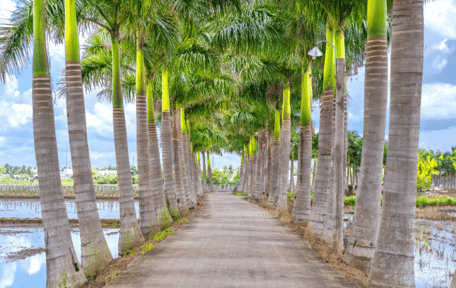
Areca Palm - Chrysalidocarpus lutescens
Looking for a pop of color inside or outside your home? Then areca palm, also called the butterfly palm, could be exactly what you need.
But do you wanna know what makes the areca palm really special? They have health benefits.
In their clean air study, NASA actually named the areca palm one of the “efficient air-cleaning plants.”
It can filter formaldehyde, xylene, and toluene from the atmosphere, and also act as a humidifier. A study from the University of Vermont even claimed that the areca palm can help reduce anxiety, depression, and fatigue.
So if you’re looking for a plant that will add to your home and your wellbeing, the areca palm might be perfect for your home.
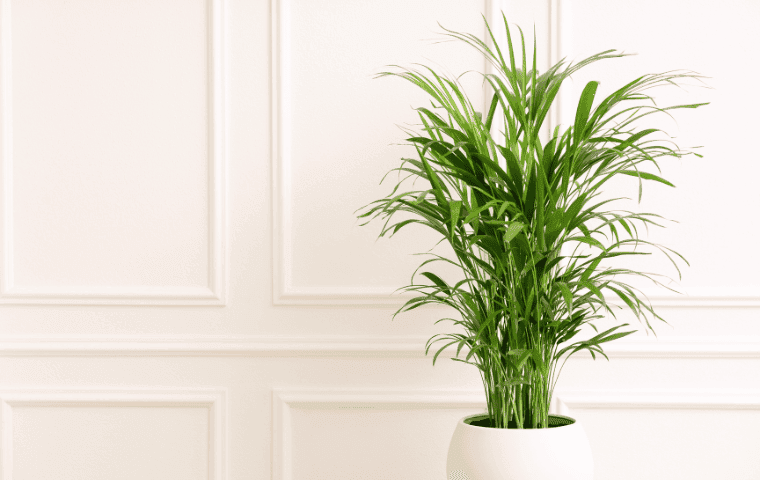
How to Choose a Palm Tree in West Palm Beach
While you may be tempted to choose a palm to fit an aesthetic, there are other factors to consider.
Here are some things to think about when choosing a palm for your home:
Inside or Outside?
Most people think that palm trees are made for the beach or poolside, but there are many palms that also work well as compact house plants.
For example, the one you would least expect - the coconut palm, can flourish in your home. All you need is a coconut, A.K.A the seed, and a pot.
While the coconut palm is a more unconventional choice, there are other popular palms to grow indoors.
The areca palm and the Chinese fan palm are perfect for a tropical touch in your home, however, you’ll need to have good potting soil and to prune them carefully to prevent the fronds from growing out of control.
How Much Sunlight Do Palm Trees Need?
Think of where you’ll be placing your palm. How much sun will it get?
Every palm needs a different amount of sun. Some palms, such as the royal palm, like full sun, while others, such as the Chinese fan, require some degree of shade.
Luckily, some palms aren’t picky about their environment. The royal palm, for example, likes anything from full sun to partial shade.
If you’re growing an areca palm indoors, you’ll want to be strategic with your placement so it stays its bright green color. Place it in bright, indirect sunlight coming from a south or west facing window.
Placing an areca in direct sunlight could turn the pure green leaves to a yellow-green color.
How Fast Do Palm Trees in South Florida Grow?
Do you want a palm to frame your poolside? Or do you want to impress the neighbors from afar and let your palm reach the sky?
It’s important to know the height of your palm before you plant it. Take note of anything that could stand in the way, like power lines or trees with long branches.
If you’re worried about potential hurricanes causing a tall palm to fall and damage your home, don’t fret. Palm trees can be incredibly resilient.
While other trees typically lose branches or fall down in extreme winds, palm trees will bend, but remain standing.
This is because palm trees don’t have a traditional tree trunk. In fact, their trunk is really more of a stem, and the stem isn’t made of bark or wood.
A palm tree’s stem is made of sclerified (hardened) cells of its former dead fronds.
This makes the palm flexible but they aren’t completely invincible either. If the ground is wet from a hurricane surge, it could be easier for heavy winds to uproot the palm.
This could also happen if you recently planted your palm and it’s in a unique area compared to its native home.
Understanding the potential height of the palms you’re considering for your yard before you plant it, is definitely worth something to think about.
Potential Risks With Palm Trees
While your kids will likely be mesmerized by a palm tree growing right before their eyes, understand that some palms have thorns and can even be poisonous.
If you have a pet, be cautious when thinking about planting a sago palm. These palms are toxic to both humans and pets when ingested.
Others, like the robellini, have thorns that can cause infections. And while the pygmy date palm has thorns that aren’t poisonous, it’s still important to be careful when handling them to avoid cuts or scrapes.
Palm Tree Care in West Palm Beach
While you may think palm tree care ends with watering, you also may be in charge of keeping your tree looking pristine. This includes pruning your palm.
Pruning is trimming the dead palm fronds. This is essential, because while you can take perfect care of your pal, the fronds won’t live forever.
When the fronds have wilted and turned brown, that’s when it’s time to prune. If you don’t want to do the pruning yourself, contact Native Pest Management, where we can help you with all things palm tree beautification.
The other good news is that not every tree needs pruning. As mentioned earlier, the royal palm is self cleaning, meaning the fronds fall down naturally.
Other palms like the coconut or the pygmy date need to be pruned about 1-2 times a year.
Before you pick a palm tree to plant, consider researching to figure out if you’ll need to prune your tree or to hire a lawn care service to help you with the pruning.
Palm Tree Pest Control in West Palm Beach, FL
Pests like whiteflies on palm trees in West Palm Beach are a known problem here and all over South Florida. Depending on which one you choose, it may or may not be a problem for your palm trees.
What are whiteflies? You might know whiteflies as the “little white bugs” and these are *especially* common with the coconut palm.
If you’re worried about whiteflies such as rugose spiraling whiteflies infesting your palms, you can plant them indoors or contact a preventative pest control service like Native Pest Management to keep your palms whitefly free.
We use our pet friendly and eco-friendly products to make sure your palm trees stay protected from any potential whitefly damage.
We can also prevent mealybugs, scale insects, and aphids from infesting your beautiful coconut palms, royal palms, pygmy date palms, or any palm tree you have your eyes set on.
If you’re planning on buying a palm tree for your yard and want to explore your options for palm tree pest control or palm tree beautification in the West Palm Beach, Port St. Lucie, Fort Lauderdale, or Miami areas, call us today or click the button below for a free quote!
